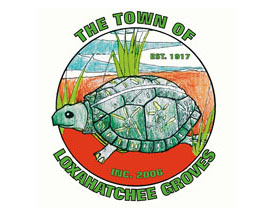The Loxahatchee Groves Town Council decided Tuesday to stop a repainting project on speed bumps that is underway until the town can get control of degraded roads it inherited recently from the Loxahatchee Groves Water Control District. The council also authorized a study to see what the cost would be to pave all town roads.
The discussion came up when Town Manager Bill Underwood reported on the condition of roads and culverts, as well as a speed bump repainting project that council members thought was too costly, especially under the circumstance that the paving might have to be redone.
Underwood said that his staff is implementing its newly adopted culvert replacement policy as it finds those that need it.
“There are three or four culverts on B Road that do need to be replaced, and we did have an issue on C Road last week,” he said, explaining that a culvert where a washout had occurred during the recent rains was right next to a power pole, and the road had to be barricaded for several days while the road was repaired.
Councilman Tom Goltzené asked why the LGWCD had not replaced the C Road culvert before turning jurisdiction over to the town.
“I have been told they have money set aside, and they did not do culverts when they initially [paved] it because they were trying to save some money,” Goltzené said, adding that he understood the LGWCD still has responsibility for maintaining the road under documents it has filed with the state. “I’m wondering why they borrowed money that they are charging people for and yet they don’t stand up to their responsibility to the town.”
Goltzené added that he thought the LGWCD had been “penny-wise and pound foolish” for not replacing the culvert before the road had been paved.
“When they had the surface off, why didn’t they do it?” he asked. “The answer is they would come back and do it later, except that later is now, and they think we’ll pay for it. I have a problem with that. It’s a consistent problem we have. Doesn’t it drive you crazy to get your tax bill and drive around and see what pieces of crap the roads are?”
Goltzené added that A Road has deteriorated to the point where there is almost no road remaining on the north end, and there are similar issues with F Road.
“You can see the road is caving in, and as you go north, it keeps caving in until there is almost no road left,” he said. “Then you look at the canals; they’re caving in. We’re going to solve the problem, but we didn’t create this problem. I wonder why we are running around like a chicken with its head cut off trying to fix something that’s junk.”
Mayor Dave Browning said that the C Road culvert does not drain town roads.
“I have no idea how long it has been there,” Browning said, explaining that the culvert had collapsed, it was removed and the road was filled to make it passable.
Vice Mayor Ron Jarriel said that part of the delay was due to a contractor who had submitted a bid of $33,000 to replace the culvert, which he said was excessive. The area was temporarily repaired by a local contractor who does work for the district and the town, until the town can get competitive bids for the replacement.
“I, personally, don’t like Tom [Goltzené] condemning the water control district,” Jarriel said. “If you ride around and look at your district roads, the ones that aren’t paved, the district put two graders on those roads Friday morning after the rain stopped, and by Friday afternoon they had every district road graded.”
He contrasted that work with the town, which only has a tractor with a box blade.
“The district is doing the best job it can,” Jarriel said. “We’ve got two entities in this town. It’s obvious that in the next couple of years, the district may become dependent. That’s only going to be if the residents vote for it. I find it hard to believe that they will support that unless the town shows a better improvement on how it takes care of town roads.”
Underwood said that at the last Intergovernmental Coordination Committee meeting, members agreed that a survey would be done on existing OGEM roads for drainage deficiencies, and then advise the LGWCD where those deficiencies were so that it could take appropriate action.
Goltzené said that he believed the town should go ahead and pave all the roads so they don’t need grading.
Jarriel said that the B Road paving project, which includes culverts underneath so there’s proper drainage to the canal rather than onto people’s properties, should be used as a model for future drainage projects.
He added that he thought that all the roads could not be paved at what Goltzené estimated as $1 million, adding that the charter does not allow the town to borrow money. Goltzené said that the town has money on hand to pave the roads, and Jarriel asked Underwood whether that was accurate.
“The councilman was referring to spending a million dollars,” Underwood said. “Whether that does all the roads or three-quarters of the roads is yet to be determined.”
Jarriel made a motion for Underwood to put together a report on the cost of paving the roads, which carried 4-0. Councilman Jim Rockett was absent.








